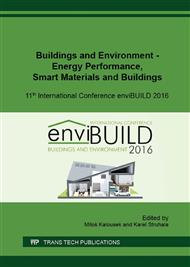p.167
p.175
p.183
p.190
p.198
p.206
p.213
p.221
p.231
Analysis of Energy Sources on Energy Indicators Performance
Abstract:
In the members states of the European Union, portion of buildings in the total consumption of energy represents 40%, and their portion in CO2 emissions fluctuates around 35%. The European Union is trying to protect the environment by reducing energy demand and releasing CO2 emissions into the air. Energy performance is the quantity of energy, which is necessary for heating and domestic hot water production, for cooling and ventilation and for lighting. Based on results of energy performance, individual buildings are classified into energy classes A to G. A global indicator (primary energy) is the decisive factor for final evaluation of the building. The new building must meet minimum requirements for energy performance, i.e. it must be classified to energy class A1 since 2016, and to energy class A0 since 2020. The paper analyses effect of the use of different resources of heat in a family house designed according to requirements valid since 2020, and its subsequent classification into an energy class.
Info:
Periodical:
Pages:
198-205
Citation:
Online since:
December 2016
Authors:
Keywords:
Price:
Сopyright:
© 2017 Trans Tech Publications Ltd. All Rights Reserved
Share:
Citation:


